Research overview
My research is focused on understanding the exotic phenomena emergent from the interplay between strong interactions, disorder, and symmetry in many-body quantum systems. The fundamental question can be posed in the following way:
What happens after we prepare a many-body quantum system—composed of spins, electrons, or atoms—in a non-generic initial state and then let the system evolve under its own intrinsic dynamics?
One possibility, which is the lore of quantum statistical mechanics, is that the interactions between particles will enable the system to reach thermal equilibrium wherein most of the details and correlations present in the initial state are ‘‘washed away’’ via decoherence—this process is called thermalization and we would say that the system is ergodic. In this case, the notion of temperature \(T\) is well defined and we can investigate the possible phases of matter and the transitions between them as a function of \(T\). We used this philosophy to study the interplay between disorder and interactions in a sheet of graphene proximate to a superconductor.
An even more exciting possibility is that the system does not reach thermal equilibrium. Notably, such non-ergodic systems cannot be studied using the tools of (equilibrium) statistical mechanics so new techniques must be used. A generic class of systems that do not thermalize is represented by the Many-Body Localized (MBL) state: not only that the constituent particles are localized in space, but quantum information itself remains localized, i.e. it spreads very slowly in time. It is in this sense that strong disorder enables coherent dynamics in interacting systems at arbitrarily long times. In various projects, together with collaborators, we analyzed these dynamical properties and investigated the stability of the MBL state itself.
Another class of non-ergodic systems that even have classical kin are glasses: the landscape of accessible states may be very ‘‘rugged’’ and the system can get successively trapped in local minima. Nevertheless, while this may take an astronomically long time, the system will eventually explore the whole space of states. In one project, we studied the role of ‘‘quantumness’’ in a glassy problem that has roots in complexity theory—in fact, it has long been considered that there is a deeper connection between glassiness and computational complexity. In another project, we levered a quantum glass as toy model for studying transitions between ergodic and non-ergodic phases.
Lastly, integrability represents another salient example of non-ergodicity. While it has been long known that regular dynamics is a hallmark of integrability in classical systems—for instance, in Kepler's two-body problem or in our own Solar System[1]—the same issue vis-à-vis quantum integrability is still not fully settled. In this vein, we studied a model that smoothly interpolates between classical and a quantum regimes on the one hand, and between integrable and chaotic dynamics on the other hand.
All of the aforementioned ideas were studied and developed in the context of isolated systems. In another series of projects, we explored the rich physics of disordered, interacting, and many-body quantum systems in the presence of external periodic driving. We showed that, by taking advantage of the coherent dynamics of the MBL state, we can obtain novel symmetry-protected topological phases and even a so-called time crystal (which cannot exist in a purely isolated system).
[1] The Solar System is believed to be quasi-integrable.
Projects
Below, I present more detailed and slightly technical explanations of the following projects:
Phase transition from maximal quantum chaos to a charge glass
Integrable and chaotic dynamics of spins coupled to an optical cavity
On the stability of many-body localization in \(d>1\)
Floquet symmetry-protected topological phases
Floquet time crystals
Classical-quantum mixing in the random 2-Satisfiability problem
Superconductivity of disordered Dirac fermions in graphene
Phase transition from maximal quantum chaos to a charge glass
 |
Ergodic quantum systems generically exhibit chaotic dynamics and ‘‘scramble’’ quantum information. Recently, very general arguments have been put forth suggesting that there even exist universal bounds on how fast these processes may occur: in particular, it has been proposed that the Lyapunov exponent \(\lambda_L\), which sets a time scale for the growth of chaos, has an upper bound \(\lambda_L \leq 2\pi k_{B}T/\hbar\) at low temperatures \(T\).
The Sachdev-Ye-Kitaev (SYK) model is an analytically solvable model of strongly interacting fermions that saturates this bound on chaos. We extend it by adding random two-site (density-density) interactions of the form \(\sum_{ij} V_{ij} n_i n_j\)—this term is a standard example of a glass, namely the Sherrington-Kirkpatrick model. If sufficiently strong, this term can, in principle, lead to a dynamical quantum phase transition from the ergodic (chaotic) SYK state to a glassy, non-ergodic state. Figure: Phase diagram in the plane of the strength \(V\) of the charge glass interactions (in units of \(J=1\)) and the energy density \(\epsilon\). The color map corresponds to the value of the glass—Edwards-Anderson—order parameter \(q_{\mathrm{EA}}\). (below) The relevant Feynman diagrams at second order \(\mathcal{O}(V^2)\) in perturbation theory: only the third one contributes to the Edwards-Anderson order parameter.
|
Integrable and chaotic dynamics of spins coupled to an optical cavity
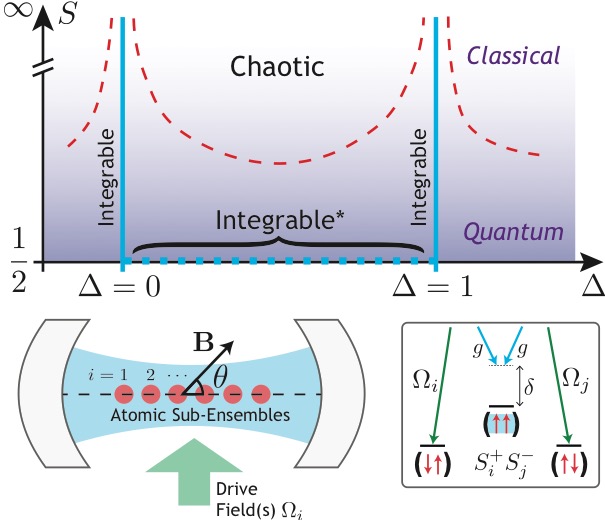 |
In this project, we study a class of spin models with random all-to-all interactions that is akin to the SYK model described above. However, the difference between the two is responsible for an even richer dynamical phase diagram, which includes regions of chaos, integrability, and of a novel form of integrability that we term ‘‘integrable\(^{*}\).’’
First, we show that there exist two special values for a model parameter \(\Delta\) where the system is integrable for any value of the spin size \(S\), as well as in the classical limit: at \(\Delta=0\) and \(\Delta=1\) the model is equivalent to various versions of the Gaudin-Richardson model and it possesses an extensive family of 2-body conserved quantities. Figure: Phase diagram in the plane of the anisotropy \(\Delta\) along the \(z\)-axis and the spin size \(S\). The model has three integrable lines: at \(\Delta=0,1\) for any value of \(S\); and a novel integrable line at intermediate \(0<\Delta<1\) for \(S=1/2\). The classical system (\(S\rightarrow \infty\)) exhibits chaotic dynamics with a non-zero Lyapunov exponent. The conjectured phase boundary between chaos and integrability is schematically depicted by the red dashed lines. (below) The experimental setup in which the model can be implemented. Reference: G. Bentsen\(^{\dagger}\), IDP\(^{\dagger}\), V. Bulchandani, T. Scaffidi, X. Cao, X.-L. Qi, M. Schleier-Smith, E. Altman, ‘‘Integrable and Chaotic Dynamics of Spins Coupled to an Optical Cavity,’’ Phys. Rev. X 9, 041011. |
On the stability of many-body localization in \(d>1\)
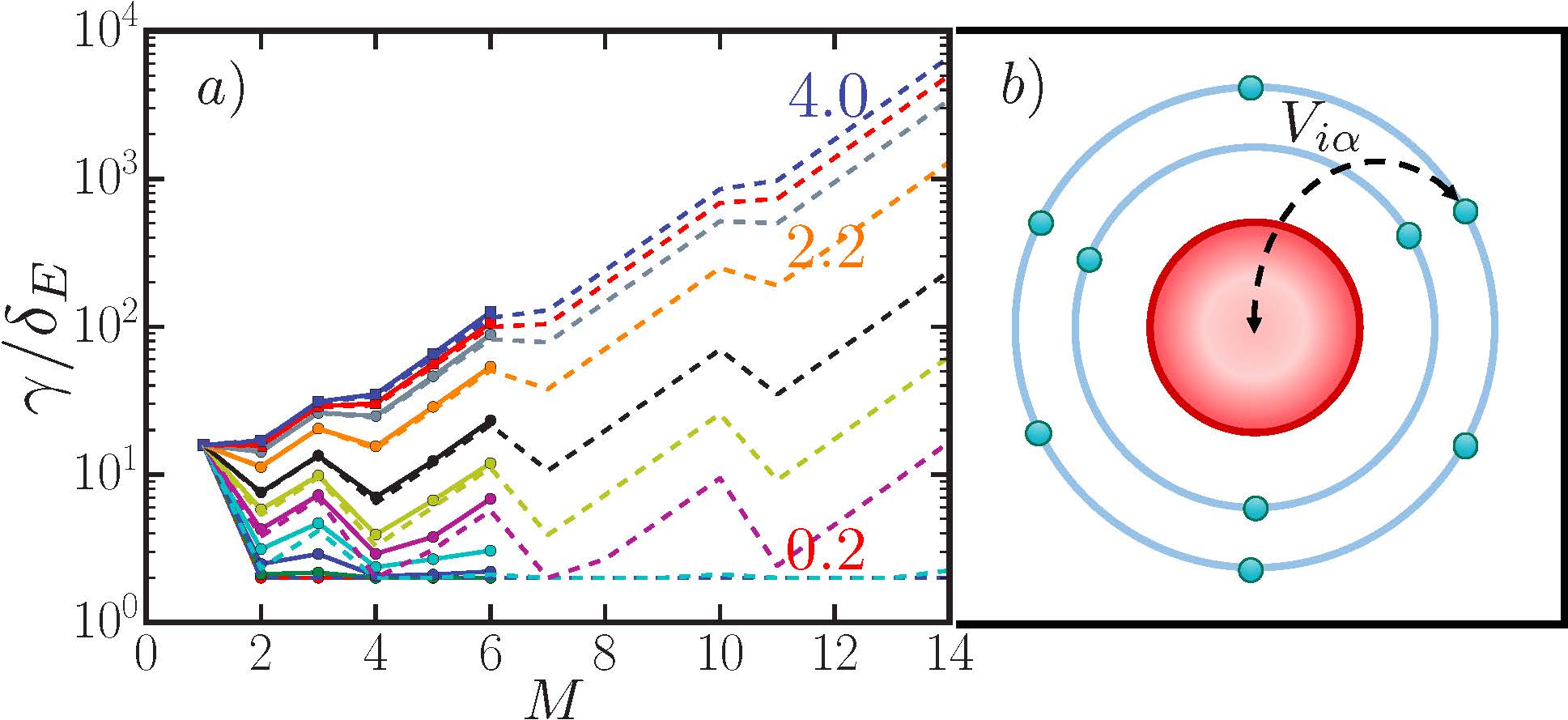 |
Thus far, we have studied two types of non-ergodic dynamics: glassy and integrable, respectively. A third example is the so-called Many-Body Localized (MBL) state, which is a generalization of ...the phenomenon of Anderson localization—P.W. Anderson showed that, depending on the spatial dimension \(d\), an electron hopping on a lattice in the presence of a random potential can become trapped (or localized) at a given site. MBL is an extension of this idea to the more generic and complicated case of many, interacting, and quantum particles. Figure: (left) The width \(\gamma\) of the spectral function peaks as a function of the number \(M\) of additionally coupled degrees of freedom for different values of the localization length \(\xi\) (different colors). The solid curves are obtained numerically, whereas the dashed curves are obtained analytically using the refined avalanche theory. (right) The \(d=2\) geometry we consider. Reference: IDP, S. Banerjee, E. Altman, ‘‘Exploration of the stability of many-body localization in \(d>1\),’’ Phys. Rev. B 99, 205149. |
Floquet symmetry-protected topological phases
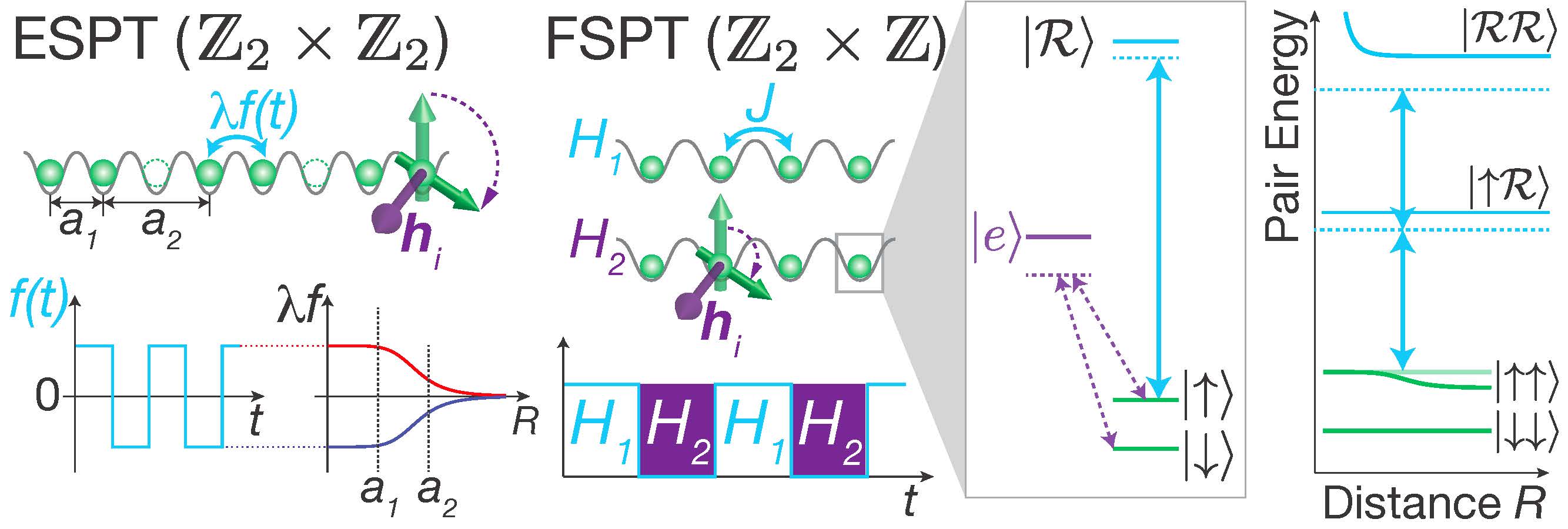 |
Symmetry-protected topological (SPT) order lies outside the conventional Ginzburg-Landau paradigm of classifying phases of matter based on symmetry-breaking. A hallmark ...signature of SPT phases is the existence of edge (boundary) modes that are robust to local perturbations that do not break the symmetry (thus the name). A famous example is the topological insulator. Moreover, the fact that these SPT systems have robust edge modes, capable of coherently storing quantum information indefinitely provided that the symmetry is never broken, makes them a very interesting candidate for quantum computation. Figure: Experimental proposal for engineering the two types of SPTs that we analyze: on the left, the emulation of an SPT protected by \(\mathbb{Z}_2\times \mathbb{Z}_2\); on the right, an intrinsically-driven SPT protected by \(\mathbb{Z}_2 \times \mathbb{Z}\) (\(\mathbb{Z}\) corresponds to the discrete time translation symmetry). Reference: IDP, A. C. Potter, M. Schleier-Smith, A. Vishwanath, N. Y. Yao, ‘‘Floquet symmetry-protected topological phases in cold atomic systems,’’ Phys. Rev. Lett. 119, 123601. |
Floquet time crystals
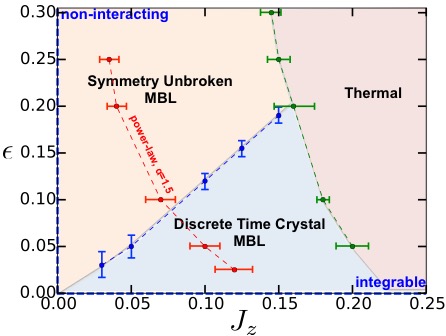 |
As mentioned before, many phases of matter can be understood within the conceptual framework of symmetry-breaking. For instance, a Bose-Einstein Condensate is an exotic \(U(1)\) symmetry-broken phase, whereas a crystal such as ice breaks the translational symmetry observed in liquid water. A very interesting and natural question is whether it is possible to break time translation symmetry? By analogy with the ‘‘freezing’’ transition of a liquid (spatial symmetry-unbroken) into a crystal (spatial symmetry-broken), this would lead to a phase that can be called a ‘‘time crystal.’’ It has been previously shown that the spontaneous breaking of continuous time translation (\(t \rightarrow t+ \delta t\), where \(\delta t \in \mathbb{R}\)) cannot occur in isolated, interacting, many-body systems at thermal equilibrium. Remarkably, however, it is possible to break the discrete time translation symmetry that occurs in a periodically-driven (Floquet) system. Such a driven, interacting, and many-body quantum system is symmetric under discrete time translations \(t \rightarrow t + T\), where \(T\) is the period of the driving field. In a time crystal, the symmetry is broken down to a smaller subgroup of translations \(t \rightarrow t + nT\), where \(n \in \mathbb{Z}\) and \(n\geq 2\). Notably, this \(nT\) period of the time crystal is caused by a combination of collective synchronization—stabilized by the many-body interactions—and Many-Body Localization, which prevents runaway heating. Moreover, this phase of matter is dual to the Floquet-SPT phase, protected by \(\mathbb{Z}_2\times\mathbb{Z}\), which was discussed in the previous section. Figure: Phase diagram in the plane of the interaction strength \(J_z\) and the pulse imperfection \(\epsilon\). The model has three phases: the time crystal (symmetry-broken) phase, the trivial paramagnetic (symmetry-unbroken) phase, and the thermal phase (since the amount of disorder is limited due to the nature of the drive). [1] Theory: N. Y. Yao, A. C. Potter, IDP, A. Vishwanath, ‘‘Discrete time crystals: rigidity, criticality, and realizations,’’ Phys. Rev. Lett. 118, 030401 |
Classical-quantum mixing in the random 2-Satisfiability problem
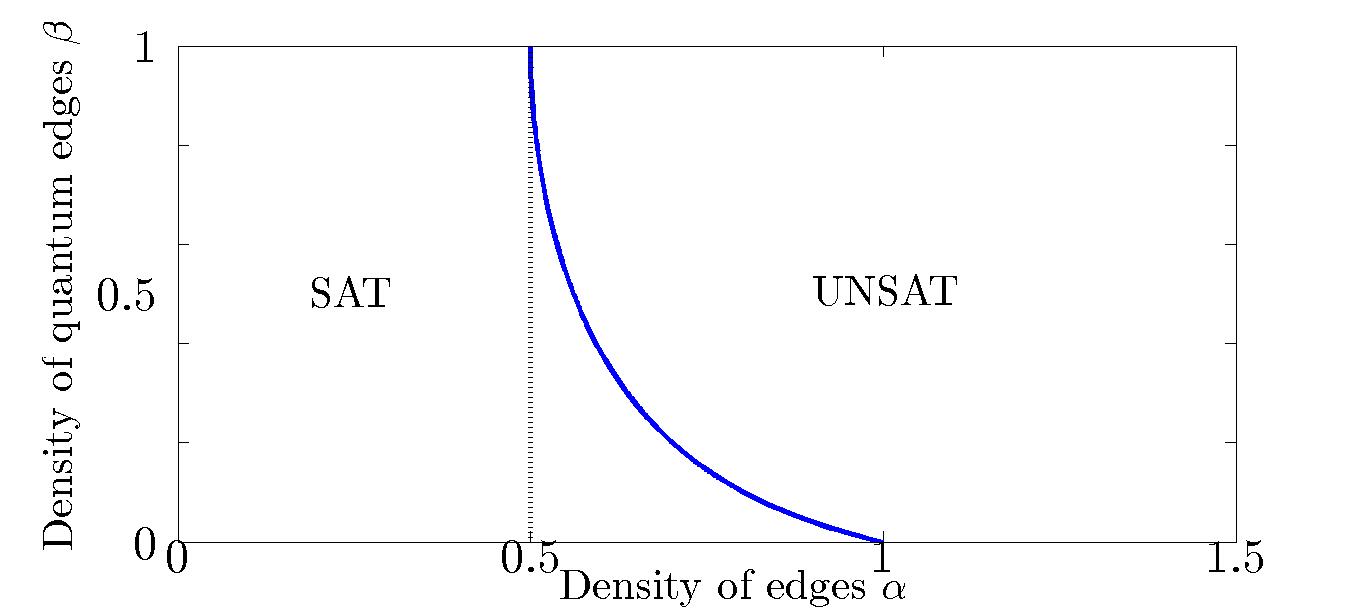 |
The random interactions present in a spin glass create frustration, which, in turn, leads to a very rugged energy landscape of accessible states. The basic intuition behind ‘‘glassy'' dynamics is that, as the system explores ...the phase space, it gets successively trapped in local minima (meta-stable states) and it takes a very long time to find the global minimum. This is reminiscent of the narrative in many optimization problems in the theory of computation—an algorithm can get successively stuck on many sub-optimal solutions for a long time before it finds the optimal one. In fact, Y.-T. Fu and P.W. Anderson have conjectured that there is a deep connection between NP-complete (colloquially ‘‘hard'' optimization) problems and the physics of glasses. Figure: Phase diagram in the plane of the density of edges \(\alpha = M/N\) (\(M\) is the number of edges in a graph of \(N\) vertices) and the density \(\beta\) of quantum edges (\(1-\beta\) edges are classical). The dashed line at \(\alpha=1/2\) indicates the emergence of a giant component in the random graph (the percolation phase transition). \(\beta = 0\) corresponds to the 2-\(\mathrm{SAT}\) problem and \(\beta = 1\) corresponds to the 2-\(\mathrm{QSAT}\) problem. Reference: IDP, C. R. Laumann, S. L. Sondhi, ‘‘Classical-Quantum Mixing in the Random 2-Satisfiability Problem,’’ Phys. Rev. A 92, 040301 (Rapid Communication). |
Superconductivity of disordered Dirac fermions in graphene
 |
We study the interplay between superconductivity and disorder in a sheet of graphene with on-site attractive interactions using a spatially inhomogeneous self-consistent ...
approach. In the absence of disorder there are two phases at charge neutrality. Below a critical value \(U_c\) for the attractive interactions there is a Dirac semimetal phase and above it there is a superconducting phase. Figure: The phase diagram in the plane of the interaction strength \(U\) and the disorder strength \(V\). We plot the order parameter (local pairing amplitude) \(\Delta_{\mathrm{op}}\) as a heat map. SC is the superconductor; Dirac SM is the Dirac semimetal; AI is the Anderson insulator; and \(V_{\mathrm{opt}}\) is the optimal disorder. Below the critical coupling (\(U < U_c\)), weak disorder enhances superconductivity, while strong disorder suppresses it. For stronger interactions \(U > U_c\), disorder suppresses superconductivity. Reference: IDP, J. Maciejko, R. Nandkishore, S. L. Sondhi, ‘‘Superconductivity of disordered Dirac fermions in graphene,’’ Phys. Rev. B 90, 094516. |